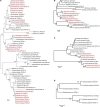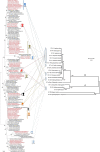High Levels of Multiple Phage WO Infections and Its Evolutionary Dynamics Associated With Wolbachia-Infected Butterflies
- PMID: 35531293
- PMCID: PMC9070984
- DOI: 10.3389/fmicb.2022.865227
High Levels of Multiple Phage WO Infections and Its Evolutionary Dynamics Associated With Wolbachia-Infected Butterflies
Abstract
Wolbachia is a maternally inherited bacterium that is widely distributed among arthropods, in which it manipulates the reproduction of its hosts. Phage WO is the only bacteriophage known to infect Wolbachia, and may provide benefit to its host or arthropods. We screened for the presence of phage WO in Wolbachia-infected butterfly species for the first time, to investigate their diversity and evolutionary dynamics. All Wolbachia-infected butterfly species, including members of the families Hesperiidae, Lycaenidae, Nymphalidae, Papilionidae, and Pieridae, were found to harbor phage WO. Interestingly, 84% of 19 butterfly species, which were infected with a single Wolbachia strain harbored high levels of multiple phage types (ranging from 3 to 17 types), another three species harbored one or two phage types. For Wolbachia strains (ST-41, ST-19, ST-125 and ST-374) shared among various butterfly species, their host insects all harbored multiple phage types, while two Wolbachia strains (ST-297 and ST-wPcau) were found to infect one butterfly species, whose insect hosts harbored a single phage type, suggesting that horizontal transfer of Wolbachia between insects increased the likelihood of exposure to phages, resulting in increased phage genetic diversity. Twelve horizontal transmission events of phage WO were found, which shared common phage WO types among different Wolbachia strains associated with butterflies. Most horizontal transfer events involved different Wolbachia supergroups (A and B). Horizontal acquisition of phage WO might also occur between eukaryotes without Wolbachia transfer. Furthermore, 22 putative recombination events were identified in 13 of 16 butterfly species which harbored multiple phage types. These results showed that horizontal transfer of Wolbachia caused it to be exposed to the phage gene pool, and that horizontal transmission of phage WO, as well as intragenic recombination were important dynamics for phage WO genome evolution, which effectively promoted the high level of phage WO diversity associated with butterflies.
Keywords: Lepidoptera; Wolbachia; butterfly; horizontal transfer; multiple infections; phage WO; recombination.
Copyright © 2022 Gao, Ren, Su and Zhu.
Conflict of interest statement
The authors declare that the research was conducted in the absence of any commercial or financial relationships that could be construed as a potential conflict of interest.
Figures



References
-
- Abe Y., Ide T., Su C. Y., Zhu D. H. (2021). Leaf galls with the same morphology induced on the same plant species by two species of Latuspina (Hymenoptera: Cynipidae), with a description of a new species. Proc. Entomol. Soc. Wash. 123 465–473. 10.4289/0013-8797.123.3.465 - DOI
-
- Batista P. D., Keddie B. A., Dosdall L. M., Harris H. L. (2010). Phylogenetic placement and evidence for horizontal transfer of Wolbachia in Plutella xylostella (Lepidoptera: Plutellidae) and its parasitoid, Diadegma insulare (Hymenoptera: Ichneumonidae). Can. Entomol. 142 57–64. 10.4039/n09-050 - DOI
LinkOut - more resources
Full Text Sources

